Toshiba Satellite P755D: Nearing the End of the Road for Llano
by Dustin Sklavos on April 11, 2012 12:00 AM ESTBattery Life
One of the places where AMD scored big with Llano (especially compared to their previous generation) has been battery life and power efficiency. Llano presently remains your best option for gaming on the battery, but somewhere along the line it seems like Toshiba may have dropped the ball with the Satellite P755D. Take a look.

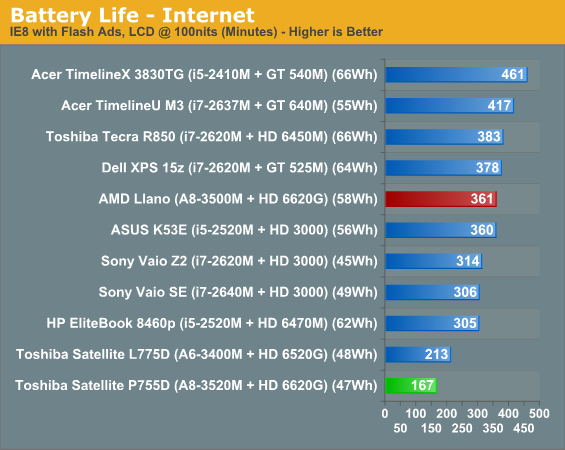
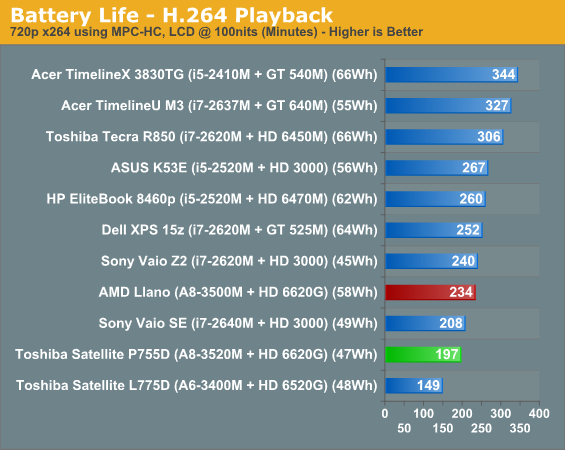
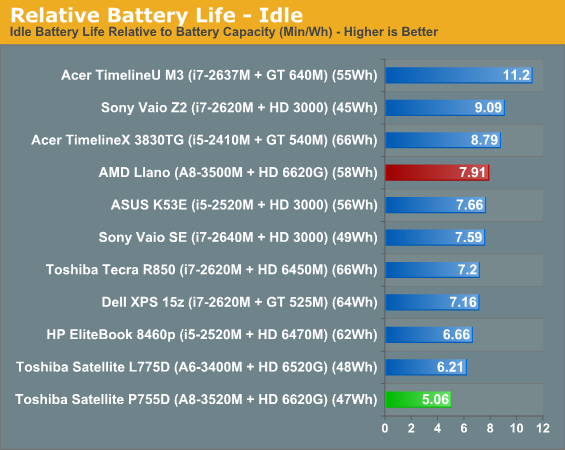
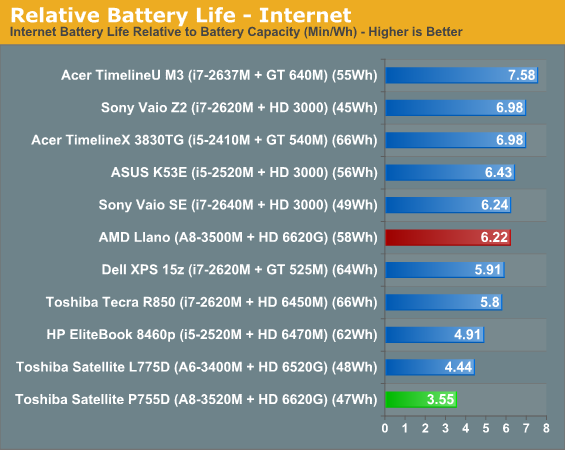
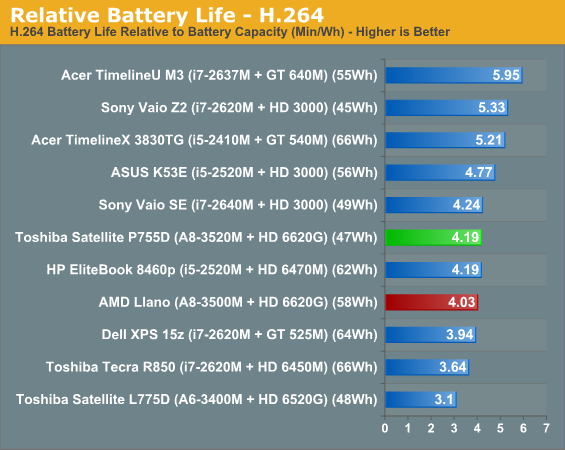
Our battery running time results seem to corroborate the results from other sites, but that doesn't actually explain why the P755D's battery life is so terrible. Llano is definitely capable of running very efficiently (our time with AMD's reference platform proved that), so I can't help but get the impression that we're running into another situation where AMD's status as an also-ran in the notebook market is resulting in less care being taken in optimizing systems that run their hardware.
Jarred's remarked on this before but it bears repeating: part of the problem with AMD processors in notebooks is that notebook manufacturers almost never took them seriously. This isn't bad hardware, but Toshiba's engineers seem to have taken only the most minimal of care with the Satellite P755D's APU. It's a decision that ultimately sells everyone on the chain short: Toshiba, AMD, and the end user. We don't think it's impossible for a vendor to produce a very compelling AMD-based notebook, but they have to be willing to try, and it's a shame nobody's really stepping up to do so.
Heat and Noise
The P755D does do right by AMD in one way: it demonstrates just what a good citizen AMD's A8-3520M can actually be in a system where heat and noise are concerned. The fans never have to spin up terribly high in the P755D, even under load, and you can see why.

HWMonitor's wattage reading is undoubtedly off the mark, but check out the thermals. While we're used to seeing other systems we test cook the hardware, the A8-3520M is running downright frosty. Seeing mobile hardware, or heck, even desktop hardware, run below 60C under stress is a very rare thing. At these temperatures it's no wonder the fan doesn't have to work particularly hard.










34 Comments
View All Comments
JarredWalton - Thursday, April 12, 2012 - link
There's a setting in AMD's control panel called PowerPlay. Set that for Maximum Performance and you shouldn't have any downclocking (except maybe on high-end parts like the 5870, 6870, etc. and above?) Using those settings, the AMD "test Llano" laptop lasted 161 minutes doing "gaming" while on battery power. I don't think Dustin tested the Toshiba, but it would be less most likely (given the other battery life numbers are all lower)--probably around two hours, give or take. By contrast, the Sony VAIO SE with a 49Wh battery and 6630M (and better gaming performance overall) lasted 90 minutes in the same test. I'm not sure how pertinent "gaming on battery" tests are, though -- most people I know don't usually play many complex/demanding games on laptops while unplugged.kamm2 - Thursday, April 12, 2012 - link
As mentioned in the article, the case on these laptops is not very desireable. A coworker bought a P755 for his daughter and I helped set it up. My wife needed a new laptop and the price and specs were good so I was very close to buying one. I just couldn't do it though due to the cheap feel of the case and trackpad buttons.stimudent - Friday, April 13, 2012 - link
I have an A8-3550MX for about a month now. It can comfortably run four computational chemistry projects while playing a Blu-ray. It has been a pleasure to use too for everything else in between.The only problem may come when the computational projects tap into the GPUs causing a slight hesitation in the Blu-ray playback.
Etern205 - Saturday, April 21, 2012 - link
I currently still have my Toshiba, but I got their business line up the Tecra. It's was the very first Intel dual core @ 1.8GHz, 512MB DDR2, 80GB SATA HDD, and Intel IGP. I later on upgrade my HDD to 160GB and installed Vista Home Premium 32bit upgrade it to 2GB and Vista runs great. No lags or slow responses where other notebooks may require more ram just to work properly.I like Toshiba, but their configurations sucks big time. Let's say you want a system with a decent GPU, then must get their 17" models. I want a 13" or so with a decent GPU, but I see none of in their line up. Even their GPU in their 17" model aren't that great compare to others.